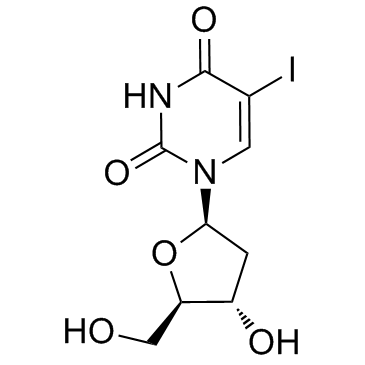idoxuridine

idoxuridine structure
|
Common Name | idoxuridine | ||
|---|---|---|---|---|
| CAS Number | 54-42-2 | Molecular Weight | 354.099 | |
| Density | 2.1±0.1 g/cm3 | Boiling Point | N/A | |
| Molecular Formula | C9H11IN2O5 | Melting Point | 194 °C(lit.) | |
| MSDS | USA | Flash Point | N/A | |
| Symbol |


GHS07, GHS08 |
Signal Word | Warning | |
|
Translating clinical findings into knowledge in drug safety evaluation--drug induced liver injury prediction system (DILIps).
J. Sci. Ind. Res. 65(10) , 808, (2006) Drug-induced liver injury (DILI) is a significant concern in drug development due to the poor concordance between preclinical and clinical findings of liver toxicity. We hypothesized that the DILI types (hepatotoxic side effects) seen in the clinic can be tra... |
|
|
Developing structure-activity relationships for the prediction of hepatotoxicity.
Chem. Res. Toxicol. 23 , 1215-22, (2010) Drug-induced liver injury is a major issue of concern and has led to the withdrawal of a significant number of marketed drugs. An understanding of structure-activity relationships (SARs) of chemicals can make a significant contribution to the identification o... |
|
|
A predictive ligand-based Bayesian model for human drug-induced liver injury.
Drug Metab. Dispos. 38 , 2302-8, (2010) Drug-induced liver injury (DILI) is one of the most important reasons for drug development failure at both preapproval and postapproval stages. There has been increased interest in developing predictive in vivo, in vitro, and in silico models to identify comp... |
|
|
Quantitative structure-activity relationship and complex network approach to monoamine oxidase A and B inhibitors.
J. Med. Chem. 51 , 6740-51, (2008) The work provides a new model for the prediction of the MAO-A and -B inhibitor activity by the use of combined complex networks and QSAR methodologies. On the basis of the obtained model, we prepared and assayed 33 coumarin derivatives, and the theoretical pr... |
|
|
Identification of a pKa-regulating motif stabilizing imidazole-modified double-stranded DNA.
Nucleic Acids Res. 43(1) , 51-62, (2015) The predictable 3D structure of double-stranded DNA renders it ideally suited as a template for the bottom-up design of functionalized nucleic acid-based active sites. We here explore the use of a 14mer DNA duplex as a scaffold for the precise and predictable... |
|
|
Rad51-mediated replication fork reversal is a global response to genotoxic treatments in human cells.
J. Cell Biol. 208(5) , 563-79, (2015) Replication fork reversal protects forks from breakage after poisoning of Topoisomerase 1. We here investigated fork progression and chromosomal breakage in human cells in response to a panel of sublethal genotoxic treatments, using other topoisomerase poison... |
|
|
Programmed cell death 2 protein induces gastric cancer cell growth arrest at the early S phase of the cell cycle and apoptosis in a p53-dependent manner.
Oncol. Rep. 33(1) , 103-10, (2014) Programmed cell death 2 (PDCD2) is a highly conserved nuclear protein, and aberrant PDCD2 expression alters cell apoptosis. The present study aimed to investigate PDCD2 expression in gastric cancer. Tissue specimens from 34 gastric cancer patients were collec... |
|
|
Neural progenitor cells orchestrate microglia migration and positioning into the developing cortex.
Nat. Commun. 5 , 5611, (2014) Microglia are observed in the early developing forebrain and contribute to the regulation of neurogenesis through still unravelled mechanisms. In the developing cerebral cortex, microglia cluster in the ventricular/subventricular zone (VZ/SVZ), a region conta... |
|
|
Probing the anticancer activity of nucleoside analogues: a QSAR model approach using an internally consistent training set.
J. Med. Chem. 50 , 1537-45, (2007) The cancer research community has begun to address the in silico modeling approaches, such as quantitative structure-activity relationships (QSAR), as an important alternative tool for screening potential anticancer drugs. With the compilation of a large data... |
|
|
Induction of lethal bystander effects in human breast cancer cell cultures by DNA-incorporated Iodine-125 depends on phenotype.
Int. J. Radiat. Biol. 88(12) , 1028-38, (2012) This study uses a three-dimensional cell culture model to investigate lethal bystander effects in human breast cancer cell cultures (MCF-7, MDA-MB-231) treated with (125)I-labeled 5-iodo-2 -deoxyuridine ((125)IdU). These breast cancer cell lines respectively ... |